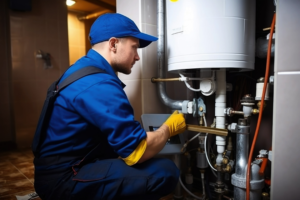Congratulations! You’ve decided it’s time for a new water heater! Perhaps your old one broke down, was unreliable, cost too much in frequent repairs, or was inefficient. Maybe you’re fitting out a newly-built home for the first time. Whatever your water heater situation, the most important thing to know is that you have options, and tank or tankless is the first thing to consider.
The tank water heater used to be the only standard option. This isn’t because tankless water heaters hadn’t been invented. In fact, they’ve existed for almost a hundred years! But it took decades for the technology to advance enough that they were an affordable option. In the 1990s, tankless systems began to be more commonly used.
If your home has only ever had a tank water heater, you might not know what the differences are or how to determine which is the right fit for your family and your budget. We’re happy to help provide as much information as you need to make your decision.
Tank Water Heaters
Some of the major benefits of a tank system are familiarity, lower initial cost for the tank and the installation, and the ability to choose the size of your tank. On the other hand, there are some definite drawbacks. Because they keep a whole tank of water hot at all times, the energy cost is much greater than with a tankless system. They also take up a lot of space in your home. Whether that’s in a closet or basement, it’s space that you could use for something else if you didn’t need that tank.
In recent years, improvements have been made to the design of tank water heaters to combat the drawback of energy inefficiency. New tank water heaters are better insulated than their ancestors, and many offer easily-operated controls so that you can set the water temperature to be lower when you are away from home and don’t need that hot water to be constantly at the ready.
Tankless Water Heaters
The most obvious benefit here is energy efficiency. Without having to heat a full tank of water, a tankless water heater only uses the energy necessary to heat the water that is called for in the moment. This means a significant decrease to your utility bills. This type of system also takes up a lot less space. They can supply up to five gallons of hot water per minute, which is plenty for most households.
However, if you have a particularly large family, leading to a lot of laundry and dishwashing as well as a lot of showering, it may not be enough. The other major drawback is the initial cost. Not only do tankless systems cost somewhat more to purchase, but the installation process of switching from a tank to a tankless heater is also more extensive and thus more costly. Of course, the energy savings may be worth the initial outlay, but it will take time for that to add up and balance out the initial cost.
The best way to determine the exact costs and how to meet the specific needs of your household is to consult with a professional. We’re always happy to answer all your questions about water heater installation in Greenwich, CT, so you can make an informed choice that you’ll be happy with for years to come.







